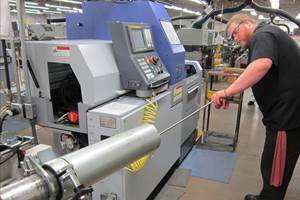Recognizing Signs of a Degrading Workplace Culture
Is your machine shop missing key “culture elements?” Here are ways to identify if your organization is heading in the right or wrong direction in terms of establishing a healthy company culture.

In the evolving landscape of technology, company culture remains a decisive factor dictating the pace of organizational adaptation and competitiveness. The simplest measures of a vibrant organizational culture are sustained profitability and a committed workforce. That said, cultural transformation, whether positive or negative, unfolds gradually.
Therefore, it is vital to monitor the direction and pace of cultural change. Tools available to measure change include employee surveys, focus groups, employee referrals, employee retention, exit surveys and so on. However, these lagging indicators often aren’t effective to assess which direction the organizational culture is heading.
Furthermore, it’s imperative to identify improvement actions with the potential for the most significant positive impact on culture. Critical cultural elements that can be noticed in the daily behavior of employees in a healthy work environment include executing to plan, focused efforts, employees asking questions during meetings, low employee turnover and consistent financial growth. These are signs pointing toward a positive “yes” culture.
Conversely, common attributes of a culture descending into dysfunction include:
A culture of “no.” Company culture starts at the top. Senior management’s attitude toward growth-related discussions might consistently skew negative as their long exposure to certain situations such as a particular plant’s suffering revenue can lead them to a biased mindset. This impedes the growth across the entire organization, as pessimistic attitudes swiftly permeate through lower management, solidifying into a culture of stagnation.
For any new initiative, a common excuse revolves around lack of resources. Employees are portrayed as too busy for any new activity and management is preoccupied in lengthy meetings. Management meetings tend to lack focus and try to address too many topics in 30 minutes while meeting participants feel they’ve squandered valuable time discussing reasons for uncompleted tasks.
Unveiling the root causes behind inefficiency and lackluster productivity could bring eye-opening insights. Oftentimes, the workforce can be seen wasting time waiting, walking and searching. Employees exhibit demotivation, simply aiming to complete their shifts without any sense of enthusiasm or engagement. A common perception among the employees prevails: “No one can alter this environment and management doesn’t understand the real issues in the business.”
Production scheduling challenges. Ideally, a weekly production schedule ought to be finalized at least a couple of days in advance and remain unalterable except under exceptional circumstances. In an unstable environment, the production schedule changes every day creating workforce stress.
Employees often unwillingly accommodate the changes to avoid confrontation with management. A daily “hot jobs” list is created for the orders that could not be completed on time, resulting in major disruption to efficient production. Frequent changes breed chaos, ineffective processes and productivity losses for both machinery and people. Consequently, it erodes the mutual respect between shopfloor employees and management.
Frequent changes in priorities. Due to the prevailing stress within the organization, management constantly fights with initiatives prioritization. Project A is a top priority on Monday and Project B becomes the highest priority on Wednesday. This indicates that the organization is attempting to juggle too many tasks simultaneously without a meticulously crafted plan. Consequently, tasks suffer from a lack of focus, teams waste valuable time and, ultimately, distrust festers between shopfloor employees and management.
Employees who don’t raise their hands during meetings. In a dysfunctional culture, employees exhibit a lack of eagerness to take on additional responsibilities. At the same time, they fear asking questions because the question might turn against them and result in added workload and/or their questions will yield no tangible changes. While feedback sessions might seem fruitful, employees often withhold the truth fearing that management lacks the capacity to accept harsh realities.
A stressful month-end. In a dysfunctional culture, workload imbalance is a common theme whereby a significant part of the monthly output is delivered to customers in the last few days of the month. Considerable production overtime is used during the last week to achieve monthly financial goals. Such an imbalance of load across weeks results in enormous inefficiency across the plant.
The higher the prevalence of these issues in the workplace, the faster the culture goes south. Embracing this observational approach offers a crucial advantage: management can pinpoint and prioritize areas for improvement with the greatest potential to transform a deteriorating culture to one that’s thriving and supportive.
About the Author
Manoj Mohta
Manoj Mohta is a certified Six Sigma Master Black Belt and continuous improvement director at Avalign Technologies. He has total experience of more than 23 years,including roles in manufacturing and assembly operations, warehousing, quality, sales and customer service.
Related Content
New Thinking from the New Generation for the New Year
“We have to learn to think in a new way.” –Albert Einstein
Read MoreStrengthening Manufacturing Workplaces Through Active Listening
A good strategy to weather the storms of manufacturing market upheavals and unpredictable factors is to commit to continuous, active employee listening.
Read MoreSuccession Planning: Three 15-Minute Activities to Start Preparing for Tomorrow
Succession planning is planning for the future success of your business.
Read More6 Tips for Training on a Swiss-Type Lathe
There are nuances to training a person to effectively operate a Swiss-type lathe. A shop I visited a while back offers some suggestions.
Read MoreRead Next
5 Aspects of PMTS I Appreciate
The three-day edition of the 2025 Precision Machining Technology Show kicks off at the start of April. I’ll be there, and here are some reasons why.
Read MoreA Tooling Workshop Worth a Visit
Marubeni Citizen-Cincom’s tooling and accessory workshop offers a chance to learn more about ancillary devices that can boost machining efficiency and capability.
Read MoreDo You Have Single Points of Failure?
Plans need to be in place before a catastrophic event occurs.
Read More














.jpg;maxWidth=300;quality=90)







